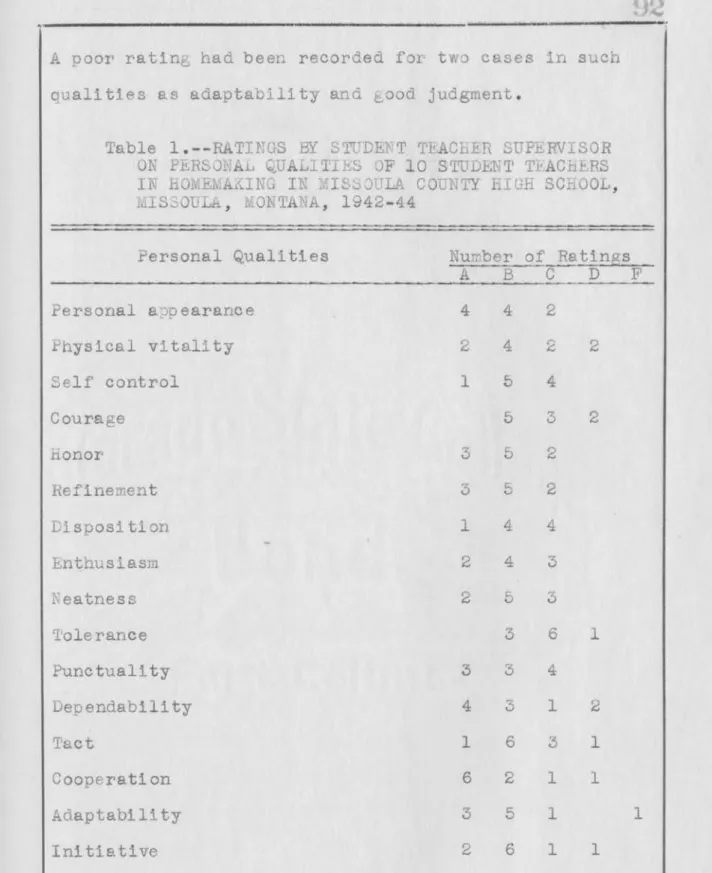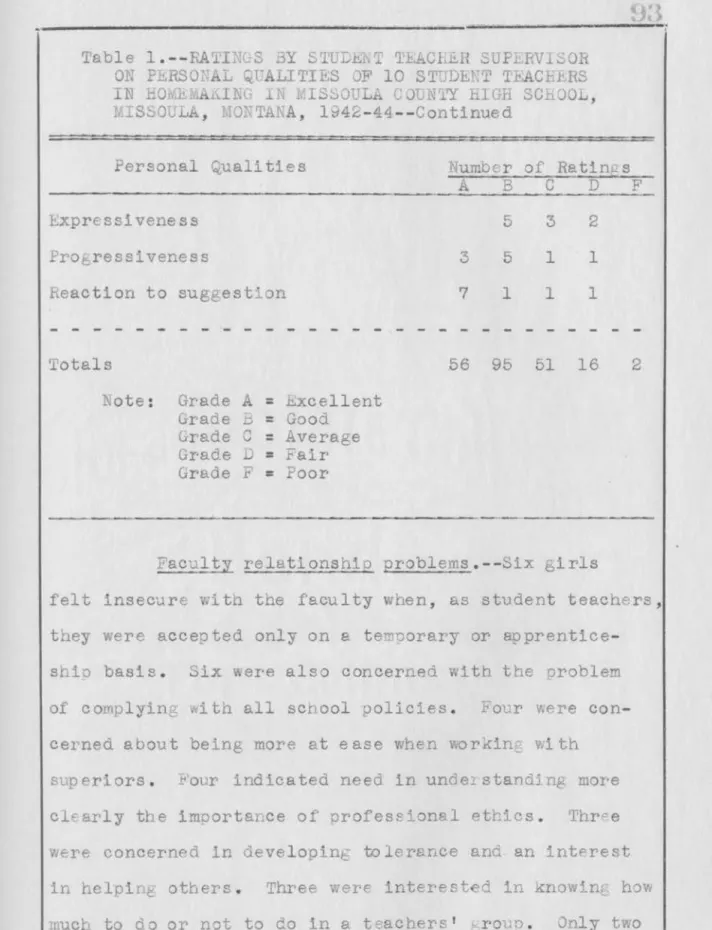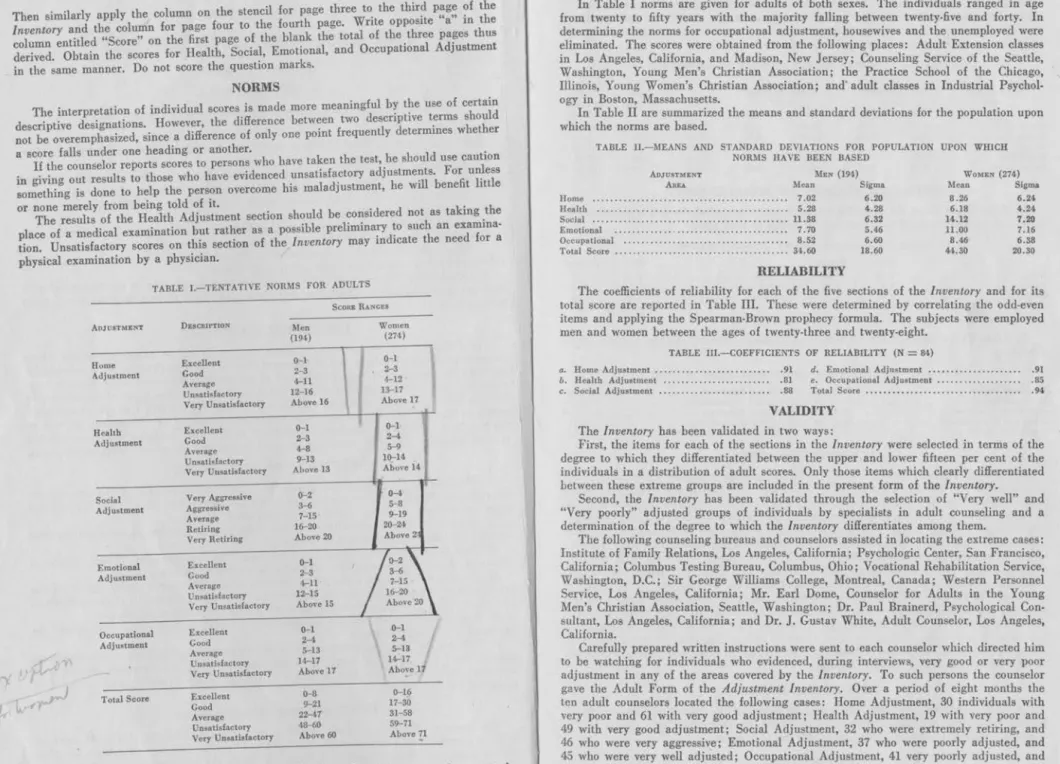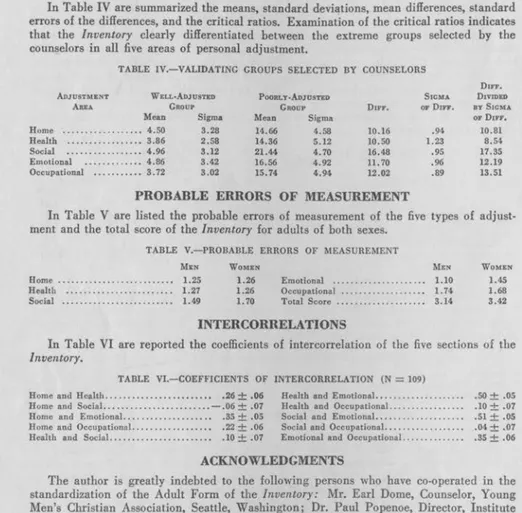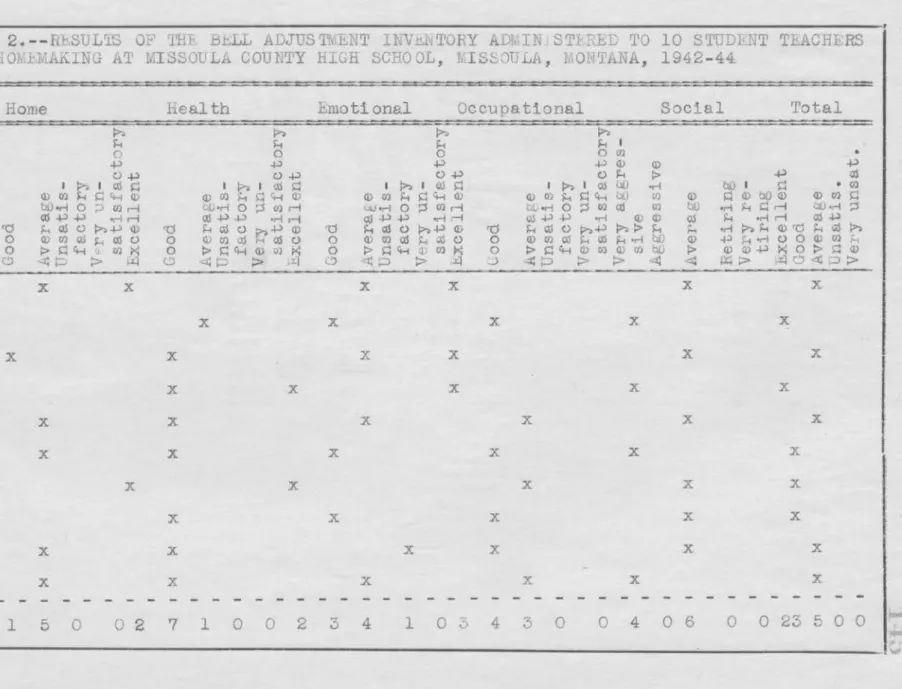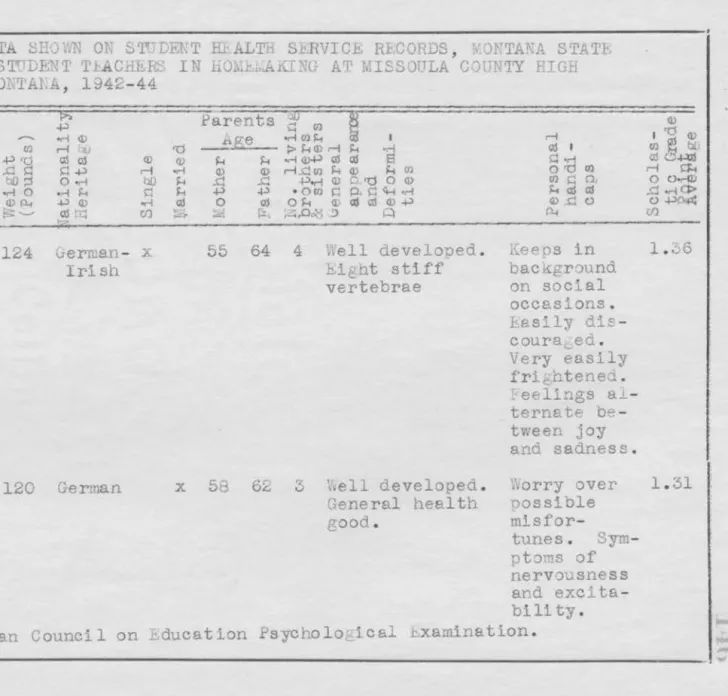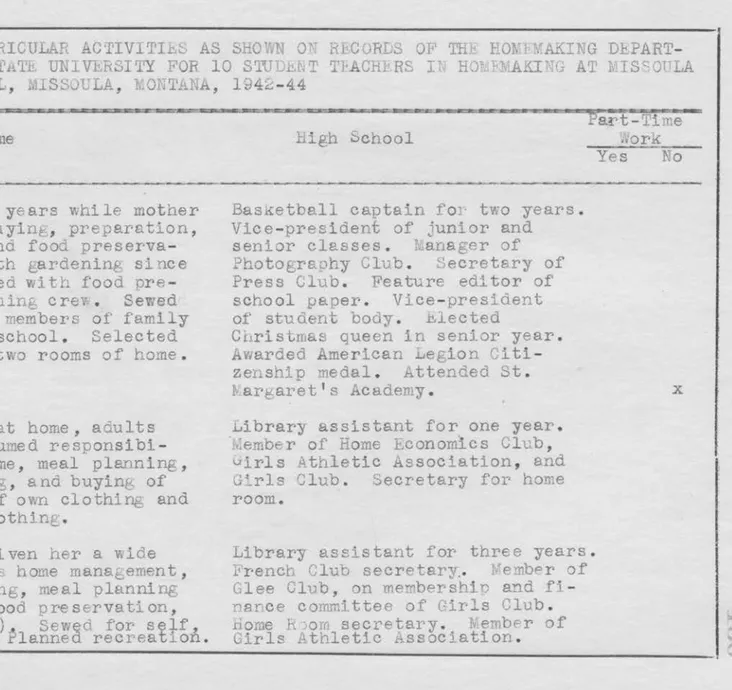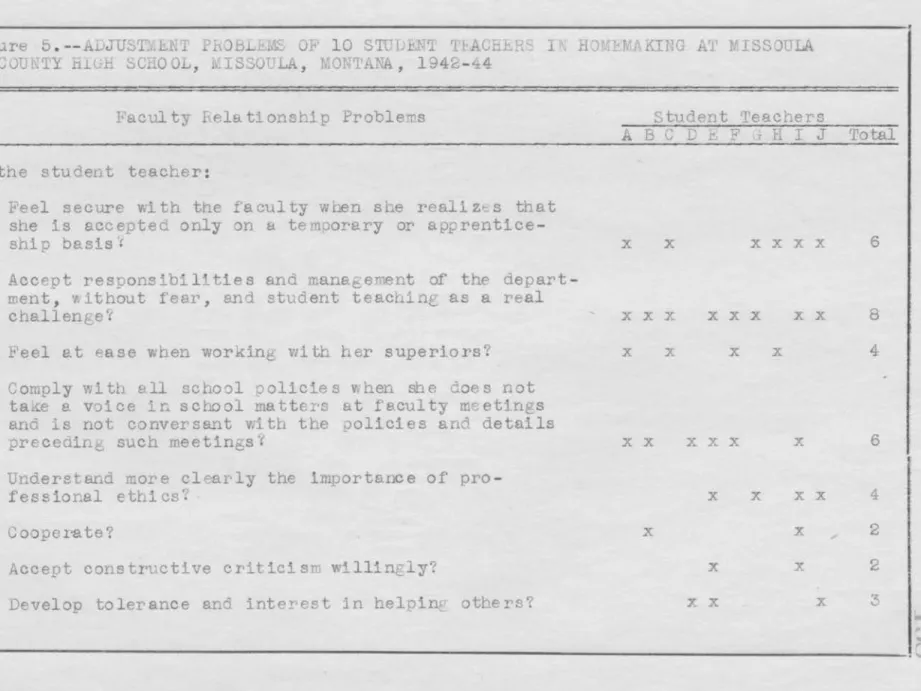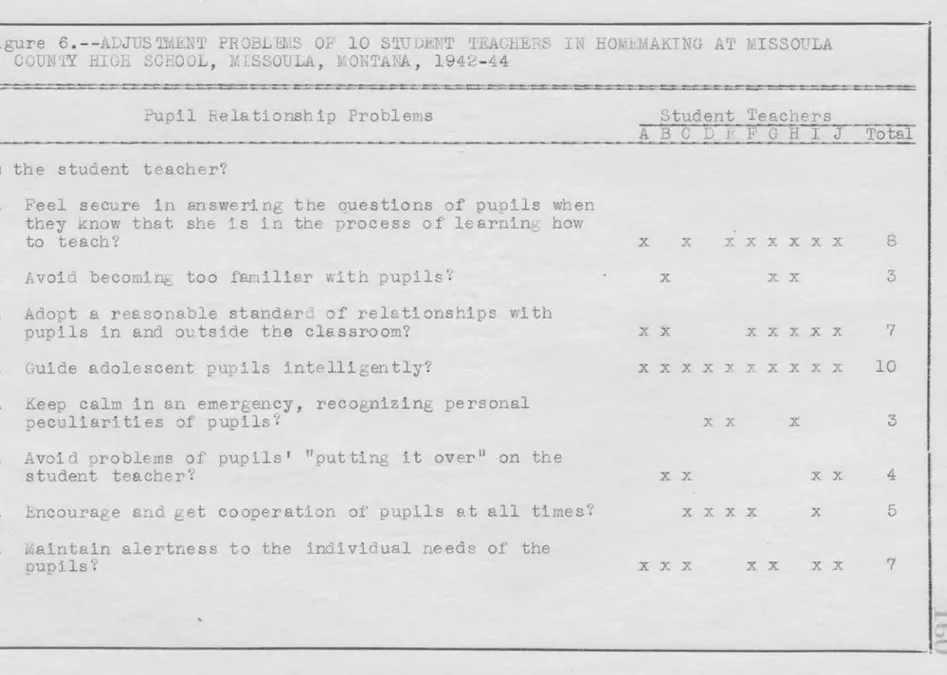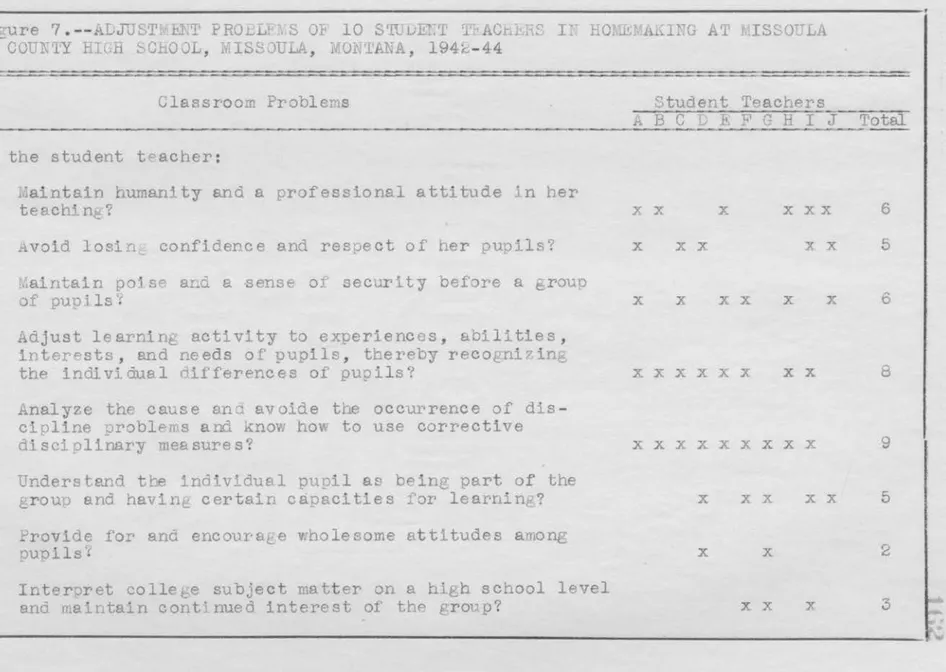ABSTRACT
Of'.
T 1 &i$ADJUST!, hHT O • STUDENT 'I'F:AChlRS TO THE ThAC IN· SITUATION
IN HO' E AKING
Submitted
by ,1arie NagovskyIn
partial
fulfillment
of the reouirements
for the
Deg
re
e
of ast r of
Fduc
atio
n
C
olorado
State
0ollegeof
A~riculture and
,
echanic
Arts
11 ort Collins, Colorado
December, 1944 ,v~·.
~•l•~~~-i~-~i-~~i
•
·~·-
... _ .. " ' ' ' - -,
~
. A
slllllllllllllllllllllllllllllllllllllllllllllllllllllllllllllllllllllll~II
U18400 907382237ti
7<?€::
AO
lq qi,/
f!,~
~ problem
What assistance
can
be given to student
teachers
ofMontana
StateUniversity
inadjusting
to theteaching
situation
inhomemaking?
Problem
ana.lysis.--In ordr
•
r
to solve thlsproblem, answers to the following questions have been
sought:
l. ' hat common problems in adjustment confront
student teachers in their relatlonsblp with
the
schoolpersonnel and with the pupils?
2.
W
hat common problems coni'ront student
teachers in their
classrooms?3. v:b.at socielproblems confront student
teachers?
Delimitation.--Investigatlons
were
limited
to
the study of student
teacher·s
who ha.d done their studentteach1n£
at M1ss~ula County High
School, ~issoula,
Montana, in 1942-44.
Definition
2.f
terms.--Adjustment, asi
t
wasused in this study, is a continuous process of
Under the supervision of the writer and to
determine recommendations for the help
and
guidance that ce.n be given to student teachers in the.tradjustment
to theteach
i
ng situation,
data. relative to the e.bove prob-lems were obtained from records and
fi
les
of the
follow
-ing offi.ces of ~:ontana State University: 'l1
he Student Health Service, 1
l'he 0.ffice of the1 Dean of V,omen., The Home :bconomics De9artment, end 'I'he Regl stra.r' s Office. r:t'he Bell Adjustment
Inventory
wasadmin
istered
to eachst
udent
toobtain
an analysisof the
student teachers' personalities.For
recording
information
concerning
common
problems, gained f romobservations
and conferences with the student teache1•s, an evaluation record of the quali-ties to be studied was designed and used by the writer, who was the studen~ teacher sup ervlsor at Missoula County High School. A series ofpersonal
conferences was alsoheld with the individual student teachers for consider-ing the problems they
encountered
during
the studentteaching period.
On the be.st s of tbe data gs. thered and ta.bu-la ted from the fo!'t)going sources, case histories of 10 student teachers were me.de. Upon analysis these
case
studies showed the
fo
llowin
g problems
to be common to
onB-half
or more
.
Summary
Qf
findingsAdjustment
2roblems
g£
student teachers
1!1
r·ela.tionsh.tps
filh
school per&onnel!.!!9.
pupils .• 1. Feellnb secure with the faculty when theyrealized that they were accepted only on a
temporary
or apprenticeship be.sis.2. Complying with all school policies when tbey
did not have a voice in school
matters at
faculty meetings and were not conversant wl th
the policies and details preceding such
meet-ings.
3. F'eeling secure in answering the questions of
pupils when they knew that the student teachers
were
in theprocess
oflearnin
g
how to teach. 4. Adopting a reasonable standard of reltl tlonshipswith pupils in
end
outside
the
classroom.
5. Guiding adolescent pupils intelligently.
6.
.1.\nowing tr...e
ba.c.l{ground of the pupils.7.
Encouraging and
getting
coopera
tion
of pupils
at all times.8. Analyzl ng the ca.use and a voiding the occurrence
of discipline problems and knowing how to use
corrective disciplinary mE:-:asurers.
9. Meintaining poise and a
sense of
securitybe-fore
a.
group of pupils.lo.
Being
human snd
maintaining
a
profe
ss
i
onal
11. Avoiding the loss of confidence and respect of the pupils.
12. Understanding that the individual pupi l i
a
apart of the group an
d
has eeztain capacities
for leamirl£,.
Problems confronting student
tea.chore
in the-
-clasaroom.--1. Accepting responsi bili. ties and manag
e-ment of the department ~i th out fear and
accept-ing student teaohinb as a real
challenge.
2.
Adjustinelearnin
g
actlvi.ties toexperiences.,
abllltiea., interests.,
and needsof pupils,
thereby recognizing the individual differences
of' pupils.
3. Maintaining alertness to the irn~lvidual needs
of the pupils.
4. evelopin6 ab:tllty to evaluate themselves in
various altuations as t eachers~
t:'.ocial problems confronting student tea.cher1t•
1. Finding sufficient ti me for recreation and
per·sonal livlnc. durln1;; student teaching perlod.
2. Developing lni tla
ti
ve and sec1..rri ty in socialunder ta;,cings.
3. ~-stablishing rapport wl th parents while ma.kin,.,
home visits.
4.
Overcoming
self-consciousnessa.nd developing
self-confidence when in a group.Twelve of the common problems were in the
area of relationship wlth school personnel and with
pupils, four were classroom problems, and five were social in nature, showing that the major difflculties of student teachers ca:m.e in the erea of relet.1.onships wit people in a professional situatlon. Since the student
t
achers a.s a group were average in scholastic standing and in physical c ondit
..
on ancl all were of thewhite race, the difficulties encountered in relationships
were no doubt due to personalities of the girls, their
social and rofeasione.l experience, end the new environ-ment in which teaching situations existed.
Recommendations
The following recommendatlons are made to aid student teachers in home economics at ~ontana State University 1n adjusting to the student teachlng sl tu-e.tion.
1. An e1ffort should be made by the universl ty to help girls develop skills 1n human relation
-ships, and every effort shoulc be made by the
supervising teacher, the superintendent, and
the university supervi sor to make the student tee.er er as much a part of the hiFh school
faculty as poesible during her student teaching period.
2 • I t would be advisable for the university to
extend the student teaching period to six or
nine weeks.
3. It would be advisable for the universi ty to
include soctal training 1n the coll~ ge curr1 ..
culum
for home
economicsstudents.
4. The sup rvl sl r.ig t ee.cher should give the
student teacher information concernin0 indi
-vidual
pupils and their home
backgrounds a.r:rl encourage home vi si tlns
£c a.rl y in the studentteaching period.
5. 1:fhe teacher training curriculu11
e.t
theuniver-s
.
ty
shouldinclude
a study of
adolescentpsy-cholo y and mente.l hygiene.
6. '!·be su.:..iervistng tee..cher should be explicit in
instructions concerning the care of the
depart-ment and should do ev rything in her power toplace responsibility on the student teacher
and to make her feel that responsibility.
7. 'Ihe supervising teacher should call the a
tten-tion of the student
teacher
to the thin s to ....look
for and shoul
d
e.sslst h
~
r continually
in
observation until
suchbservations become a
ha.bit.
8.
1hesupervising
teacher shot1ld show thestu-dent teacher hon to uce upon herself the techniques whlch the supervi sor uses in
9. he supervising teacher and the
colle
.,eteacher tro.iner should aee thst the student
teacher
makes unit
plans for the entire
.
eriod,
early in the student teaching period.
10. :i.: e student teacber- should make .,,:1.si ts to
the teach1n center and should have conferences
l th. tbe supervising teach(0'r before the teach-ing period begins.
11.
Students in colle
c
e who are
looklnLforward
toteachlnc should in some way,
earlj
in theircoll
.e course, be made to appreciate thevalue
of partic1patin actively in the social
life of the college and their home- communl ties.
12. The student teacher should take advantage of
the numerous op)ortunit1es that arise in the
school and community by which she may develop
initiative and become more secure in making decisions in social undertakings.,
roblf'm.s for further study
As a result 01' this stu y l t is recommended that a f rtl f-r an'"' lysis of the r:>roblem be mede through
the study of the :follo in questions:
1. ,h t e tho· s and tea. chine... devices are best adapted by the student t ac.her in h mema · ine:,'?
8 part-time,
one
period per day teachin .pro-gram in h
m1ema;c;:1ng, and
afull
-
day
studentteaching r.,rogra"l'l?
3. 'hat difficulties
are encounter
d by thefirst-y0ar
teacher in ho nema ing't'4. hat
effect
maya
heavy universityr
collegeschedule have upon the student teacher durin
her atu
ent teaLhin
g
period?5. How may a
university
or
collece
curriculuminclude cru1·ses whlch will show the prosoect1..ve
t
acher how to teach skill courses so thatthPy will met individual needs of pupils?
6. is i t possible, early in a student's college
career, to determine qualities whtch will
point
to success
in the teachin field?A~T
1,,;E
C.,'..LtCi. 0
1'.
l
•
T H E . S l S
ADJUSTM:!!,NT OF STUDENT 'l'EACH~RS
TO THE '11
~A.CHING SITUATION IN HOMEMArCING
Submitted by
l ari e Nagovsky
In partial fulfillment of the requirements for· the Degree of l'iias ter of hduc a ti on
Colorado State Colle c"e of
Agriculture and Mechanic Arts F'ort C9llins, Uolorado
December, 1944
LIBRARY
t.;0l0r?A:){J
5TA!'E GOU
.E
GE
OF
A.
&
I.
l
J;"Ofl"I co~ L J~<lj ~OL.QftA04---
...---,
__
..
______
,,__
.,...___
~_
..._.
___
.---
... - ,·. _.,._·~ ... - ' .. ' ... , ... , ~COLORADO STATE COLLEGE
OF
AGRICULTURE AND MECHANIC ARTS
...
.
.A1+.@.~.t. .. J.R
..
..
.
...
..
194.1 .... ..I HEREBY RECOMMEND THAT THE THESIS PREPARED UNDER MY
SUPERVISION BY MA~IJ:,; __
;JAQ9.Y~:fS:Y ...
..
....
...
.
...
..
. ... ..
$.I
TlA;J;JPN .. )),
_J!_q_~v1_,!:!,lu\A,_J}·~.9 .... _ ... ..BE ACCEPTED AS FULFILLING THIS PART OF THE REQUIREMENTS FOR THE
In Charge of Thesis
APPROVED ... ... -- . .. ·
Head of Department
Examination Satisfactory Committee on Final Examination ~ ~- . m ~·.1./ ...
c
· . . .
~ .
(Ja/;-,-....
...
..
..
,~.r--·i'
...
...
... ..
) ~ ~ L E . ~
.
...
.
.
.
...
\t.Q
..
.
.
~
...
.
...
.
Dean of the Graduate School
Permission to publish this thesis or any part of it
must be obtained from the Dean of the Graduate School.
ACn.NOWLt.DG 'hN'l'S
The writer wishes to express her apprec5-a tion to the following faculty members of Colorado State
College for their interest and guidance in the develop
-ment and writing of this study: Dr. i':iaude 1,illiarrson,
Associate Professor of home Economics Education; Dr.
Everett B. Sacket t arrl Dr. David H. !forgan, Supervisors
of Research in home hconomics 1:!ducation; Irene Coons,
Reference Librarian; and Gle.dys ~ddy, :B..nglish Adviser.
Appreciation is also extended to Edith harwood, Montana State Supervisor of home 1<,conomics,
and to the following faculty members of J •• ontana State University for their contributions and assistance in
this study: Helen Gleason, rofessor of home Economics;
.ur. ..alter R. Ames, .Professor of Education; and Dr.
Chapter I I I III
IV
VVI
rrABLE OF CONT:B.NTS Il\TRODUC'.1ION • • Page 7 The problem • • • • • • • • • • • • • • 8 Problem analysis • • • • • • • • • • 8 Delimitation . • • • • • • • • • • • 9 Definition of terms. • • • • • • • • 9 REVIE½ OF1LITERATURE
RE.LP.TING
TO THEADJUS '.l.1
ME1'TT OF STUDhNT '.l.1FACHBRS. • ME1H OD OF PROCEDURB.. •
ANALYS.iS OF DATA • •
.
.
.
. .
Case histories of 10 student
10 24
28
teachers • • • • • • • • • • • • • • 28 Analysis of case histories . • • • • • • 87 Personal data. • • • • • • • • • • • 87
.t' anily and home background • • • • • 88
Academic record. • • • • • • • • 89
:bxtra-curricular activities . • • • • 90
hmotional adjustment problems
during student teaching • • • • • 91
Faculty rele tionshj p oroblems. • • • 93 Classroom adjustment problems. • • • 94
Social adjustment problems
during student teaching: • • • • • 95
DISCUSSION
• • • • • •
.
.
.
.
.
.
.
Adjustment problems of student teachers in relationships with
97
school personnel and pupils. • • • • 97 -Problems confrontin~ student
teachers in the classroom. • • • • • 99
Social problems confronting
student teachers • • • • • • • • • • 99 Recommendations • • • • • • • • • • • • 103 Pro bl ems for further study. • • • • • • 106 SUM!'l,ARY. • • •
.
.
107 The problem . • • • • • • • • • • • • • 107 Problem analysis • • • • • • • • • • 107 Delimitation . • • • • • • • • • • • 107 Definition of terms . • • • • • • • • 107 SumiTiary of findings. • • • • • • • • 109Chapter ... TABLE OF CONTENTS Adjustment proble~s of student teachers in relationships with
school personnel and
pupils • • • • • • • • • • • •
Problems confronting
student teachers in
the classroom • • • • • • • • •
Social problems
confront-int student teachers • • • • •
Recommendations • • . • • • • • • • • •
Problems for further study • • • • • • • APibNDIX • • • • BIBLIOGRAPBY
.
.
.
Page 109 110 110 111 113 115 166---·-
- - ·
LIST OF TABLES
'I'able
1 RA'I'IKGS BY S TUDhfJT TMCHBR SUPIRVISOR ON PERSONAL Q.UALI'rI ES OP 10 S'J.11:TDKFT
'TEACHERS IN HOMEMAKING IN T•HSSOULA
COU~TY HIGH SCHOOL, . ISSOULA,
Page
MON'.I.1ANA, 1942-44. • • • • • • • • • • • • • 92
•
Chapter I
I NTRODUC TI ON
At Missoula,
M
ontana, County High School
athre
e
-week
student teaching progra
m.
has been arranged
with the
M
ontana State University.
The student teachers
report to the high school homemakin
g
classes daily for
the entire day.
They participate in the school pro
g
ram
beginning with observations of homemaking class
proce-dures.
According to their learning speed, they
gradu-ally assume the responsibilities of the regular teacher,
until the responsibility of all classes for the entire
day is turned over to the student teacher, who receives
aid when needed from the regular teacher.
One of the most desirable accomplishments of
student teachers is tre ability to cope with special
situations that present themselves durin
g
the student
teachin
g
period.
Recent social trends, economic changes,
and unrest, coupled with
anew environm
e
nt,
p
resent many
new adjustment proble
m
s varyin
g
in nature and quality.
Oftentimes fear retards the social relationships and
academic achievements of the student t
e
ach
e
rs;
astate
of worry is thereby created that further impedes the
solution of their troubles and is detrimental to the
wel
f
are of those exp
e
riencin
g
difficulties in adjustment.
___
It has been said that normal people, as well as abnormal people, have problems which may arise in any period of life. If these problems are not solved satisfactorily, success and happiness are not realized
by the individual. It alrohas been recognized that
there is a definite need for increased emphasis on the consideration and understanding of adjustment problems of student teachers in homemaking education.
Student teachers in Missoula. have frequently
expressed a desire for more help on such problems as adapting themselves to classroom situations,
participa-ting in professional and extra-curricular activities, becoming acquainted with the home and with community problems, planning for desirable improvements, and attaining security in their teaching.
The problem
What assistance can be given to student teachers in adjusting to the teaching situation?
Problem analysis.--It will be necessary to answer the following questions:
1. \ivba t common problems in adjustment confront student teachers in their relationships wit b the faculty members and other employees of the school and with the pupils?
2. What common problems confront student teachers in their classrooms?
3.
What
social
problems confront
student
teachers?
Delimitation.--This study includes the student
teachers
who did
their student teaching at
Missoula
County
High School
in
M
issoula.,
Montana.
,
during the
school years 1942-44.
Definition of terms.--Adjustment, as it is
used
in this study, is
a.continuous
process of
adapta-tion of the individual to his environment.
Chapter II
IlliVIEW OF LITERATURE RELATING TO THE
ADJUSTMENT OF STUDENT TEACHERS
At
some time every student teacher hasprob-lems that are difficult to solve. Some of these
prob-lems deal with her relationships with the faculty
members and other school employees, with the pupils in
the classrooms, and with matters of a social nature.
It ls important that recognition and help be given to
the student teachers in making these adjustments to insure a better understanding and a sense of security
in their teaching. Within recent years leaders and
educators have become aware of the significant
impor-tance which the area of adjustment presents in student
teaching. It ls the purpose of the writer to present
the opinions, ideas, and findings of others in this
field, limiting the study to literature 1Ahich deals
with problems that student teachers have in adjusting
to the teaching situation.
In 1930, Alexander (1) said that student
t~acting should include not merely exercises in
develop-ing skill in classroom instruction, class management and
control, but also contact arrl practice in all phases of
In 1932, Johnson (20) reported from a study
made at Iowa State College the relationship of
person-ality ratings and aptitude test grades with student
teaching grades of 450 students in home economics
edu-cation.
Jo~n£on co
n
cluded that personality as measured
by the personality trait ratin
g
s is an important factor
contributing to student teaching success and that
per-sonality trait ratings which
.
contribute most to success
in student teachin
g
are the ratings on the traits
judgment and firmness.
In an article in Practical Home Economics,
entitled, "Developing a Philosophy for Homemaking
.r.'..du-cati on,
11M
intle (26) in 1932 stated that the leaders
or teachers are first of all inc;:}lividuals, a part of the
social environment of the students, and that because of
association with them in this capacity, the teachers
need to be not only carefully prepared in the techniques
of teaching and thoroughly versed in the content of
prims
.
ry and correlative subject matter but also people
of vision, perspective, unity, vigor, initiative,
dis-cernment, and personality.
They need not only to have
ha
d
but also to be having interestin
g
and fine
experi-ences which leave a wholesome attitude toward youth and
society in the present day.
In an article in Practical Home Economics,
entitled, "The High School Student and Emotional Control,"
---
··
---and unconcerned attitude shown by parents arrl teachers
towards the growth of love and affection is often a
source of trouble. 11My teacher doe sn It like me; she
wants me to fail. She'd like to get something on me
so she could kick me out of class." Such a report must
be combatted even though it may be true.
In 1933, Eliassen (15) said that most
investi-gators agree that in addition to scholarship other factors also influence teaching ruccess.
Newsom (29) in 1933 reported a study designed to find a reliable basis for predicting success in
stu-dent teaching in home economics. From the results
ob-tained in this study, she concluded that the grade in
special metbod s was the only one. of the measures used
upon which an estimate of the grade in student teaching
might be based and that the other factors might have
affected teaching but did not appear to be of any
sig-nificance in predicting the student teaching grade.
Wbile these results are not directly related to the
present study, Newsom1s work is pertinent in that it
does relate to personality and success which are effected through adjustment.
In 1935, Strang (41) stressed the role of the
teacher in creating an environment which would give her
the right attitude. her role is hard because the
solu-tion of all problems is not within her control. Accord
important factor in teacher-pupil relationships. Her heal th, e.tti tudes toward life, and interests outside of
school are some factors which influence pupil-teacher
relationships. Strang also stressed that adjustment is
continuous. It is part of tre process of living.
Prob-lems of adjustment may involve conflict between the
individual and his environment. Acquiring the ability to
work or play wholeheartedly so that there i s no
dissi-pation of emotional energy; being willing to face
reality even if it is unpleasant; buildiD£
self-confi-dence and respect for one's abilities, and at the same
time recognizing one's unmodifiable limitations without
bitterness; acquiring a genuine and friendly interest in people; taking an objective attitude toward oneself and
others; developing a sense of humor; building an
atti-tude toward work as 11one way of having a good time";
meeting competition without resentment; and accepting
reasonable authority without rebellion--all these are,
in a positive sense, the problems of adjustment.
The study of adjustment problems, as pointed
out by Strang, is of value to the teacher in at least
three ways: (1) in indicating the kind of difficulties
students are meeting; (2) in preventing problems that
might arise if certain changes in the environment were
not ma.de; and (3) in evaluating the relative importance
of existing problems. Since a wholesome personality is
built fundamentally on positive characteristics already
existing to so me extent, i t is desirable for the teacher to focus her attention on the individual's
accomplish-ments rather than upon his faults . whenever these
de-sirable characteristics are present in any degree, they
should be reinforced and developed by approval and
opportunity for practice.
In the competitive classroom situation, only
a few can attain prominence. Many acquire a sense of
failure. Being thwarted in their efforts to achieve
academic success, they seek satisfaction in gaining
attention through defiance of authority in delinquency,
and in other forms of undesirable behavior. The teacher
can help the students meet this situation in two ways:
(1) by setting standards in terms of ability and
dis-covering som~ line of endeavor in which each individual
can excel; and (2) by helping students accept
unavoid-able defeat without evasion or emotionality. An
impor-tant principle is that a conflict can be used to help
an individual grow. A difficulty is not necessarily
destructive, nor even undesirable. The facts of the
present should be faced with a view toward making
neces-sary modifications in the environment or in the attitude
toward the difficulty. Giving the individual confidence
that improvement is possible is frequently an important
factor. An attainable goal set by the individual him~
self evokes his persistent striving towards it. If
failure should occur, a constructive attitude toward it
---·---
..
must be taken. Rather than being something to be
asharre d of, fs.ilure should be an opportunity to learn •
.Knowing what to a void is often as important as knowing
what to do. Handicaps have served as stimuli to
excep-tional achievement.
~lliott and Elliott {16) in 1936, said that normal people, as well as abnormal people, have problems which arise in all periods of life. hnvironment has an
important role to play in the solution which an
indivi-dual makes to any problem. Knowledge and experience are
necessary to solve mental problems. If these problems
are not solved satisfactorily, success and happiness are
not realized by the individual.
In 1936, Morgan (27) said that the principles
of mental hygiene can be clearly sts.ted. Facing life
squarely is one of the first of these principles. Tfontal
health depends on recognizing minor beginnings of
malad-justment am correcting the~ in their early stages.
Attitudes are learned and are forces behind motivating
behavior. Some attitudes are unconscious and provide
the basis for queer conduct.
In a report to the world conference on
educa-tion at Cheltenham, England, in the summer of 1936, the
International Commission on Teacher Training of the New
Educational Fellowship summarized the views of
represen-tatives of 34 countries as follows:
In a. di_scussion on the persona.li ty of the teacher there was general a6reement that
an academic culture, even when combined with a mastery of professional techniques, was no sure guarantee of success. All felt that
greatly increased emphasis should be placed
upon the cultivation of certain personal qualities, and that to do this the present structure of our training colleges would have to be radically changed (34:192). ·
Meyer (25), in his report entitled, ttPerson-ality Can Be Cultivated," in 1937 concluded that al-though the usual quantitative approach to measuring the teacher's personality is in semester hours, points, or degrees, there is a definite place for a quali ts.ti ve approach for cultivating teacher personality. lie
fur-ther made the statement that a degree may be an asset in getting a position, but it does not guarantee success in holding that position.
In 1938, Anderson (2) stated that there is universal agreement on such general characteristics of successful teachers, as (1) enthusiasm for and broad schola.rship in one or more fields of knowledge, ( 2) ability to deal with principles underlying the subject
matter rather than the mere facts within the subject
matter, (3) an appreciation of what richness in learning
means to the progress of civilization, (4) sincere
enjoyment in t eaching, (5) open.mindedness toward all
?
aspects of learning and of live, and (6) the ability to arouse and stimulate students to self-activity along wholesome lines.
'
He further states that the more important
function of teaching is the development of right a
tti-tudes, proper ideals, and worthy appreciations.
Success-ful teaching demands more than ample pre-service training
and proper supervisory assistance in service. There are
certain physical factors that must not be overlooked,
such as (1) suitable and attractive clothing; (2)
com-fortable and attractive living quarters; (3) proper and
adequate food; (4) provision for recreation and social
life; (5) cultural environment; (6) opportunity for
pro-fessional ·study; and (7) sufficient savings to provide
for sickness, accidents, and old age.
In an article in Practical Home Economics
entitled, "My Experiences as an Apprentice Teacher in
Vocational Homemaking," Anderson (3) in 1938 stated that
good living conditions have a direct influence on one's
personal attitude tavard teaching and that experience as
an apprentice teacher make one feel more enthusiastic
over the work whi ch is yet·before him (3:196).
Gillespie (19) reported in 1938 in her
investi-gation entitled, "Personality of Supervisors of Student Teaching of Rome Economics,11 that some home economics
teachers may exhibit an extrovert personality to a
marked degree. Traits also considered significant by
state supervisors and teacher trainers were judgment,
enthusiasm, cooperation, friendliness, leadership, and
independence. These findings further indicate that
relationships do exist between certain personality
factors and teaching ability.
In 1938 Ryan (36) in his book, ~ental Health
Through Education, made the following statements:
It cannot be too strongly emphasized that
the r eal question in teacher preparation today
is not that involved in the perennial and
fu-tile controversy between the respective
advo-cates of "knowledge of subject matter" and
11methods of teaching.11 It has
to
do withsomething much more fundamental than this.
What is involved is a new kind of teacher
preparation, made necessary by a new kind of
education. Those who are leaders in this
kind of education are convinced that wholesome
teacher personality, understanding of human
beings to social living transcend in
impor-tance any mere factual knowledge or techniques,
useful though these are in their proper
setting (36:125).
He also stated that many writers are thinking
of positive mental hygiene instead of preventative
men-tal hygiene. Teachers play an important part in molding
child behavior. A healthful school atmosphere can be
created by the teacher if she is well-adjusted herself.
Wholesome surroundings, sympathy, understanding,
affec-tion, and security are necessary for good teacher-pupil
relations hips. The child must be considered as an
indi-vidual and should be dealt with according to his own
needs and abilities. Growth and development proceed at
different rates in different individuals. There is
always a cause for behavior which must be known if mental
hygiene problems are to be solved.
From the results obtained in her study,
l
Capo (10), in 1939, stated that since teachers in
train-ing, as seniors in colle
g
e, cannot anticipate the
situ-ations in which they will later b
e
employed,
they should
be
prepared
for and have
some
experience in
the
various
situations in which they may find themselves.
Prospec
-tive teachers need experience in school activities and
an opportunity to become acquainted with h
o
me and
com-munity problems
.
At the same time, they should be
learn-ing to adapt themselves readily to existlearn-ing conditions
and should be planning for desirable improvements.
In 1939 Fallgatter (17) in her article in the
Journal of Home
Economics
said that perhaps
.
the
most
significant
point
of progress to be reported in the fi'eld
of teacher education for home economics is the
general
awareness of the need for careful study
of
the
problems
related to (1) the selection of teachers, (2) curriculum
offerin
g
s to provide for the broadened philosophy of
education for home and family, and (3) enriched types
of experiences for students who are preparing
to teach
home economics
•
What
can be said to a
girl when
she says,
"My step-mother doesn
It want me around and my dad's too
busy to pay attention to
me
.
I
get
plenty to eat and
wear
and all the money I want, but they don't care
what
I
get
on my report card.
They never said a word when I
got
a story in the school paper or ma.de the class team."
No
one
with whom
to share triumph, no one with whom to
talk over ambitions or desires, no one interested unless
she over-step?ed or made trouble.
The adolescent needs someone in whom to
con-fide, and due to the
g
rowin
s
feelin
g
of independence, he
us
u
ally finds someone outside the family.
This is the
teacher's opportunity.
½
hen she becomes the con
f
idant,
g
uide, and counselor, chosen t
h
rou
g
h chance or desi
g
n,
she can reassure the student by helpin
g
him understand
his family as well as himself.
Perha
p
s no task is so stupendous as that which
the parent, the te
a
cher, and the child himself attempt
in the control and subli~ation of the pr
i
mitive reactions
o
f
t
h
e emotions.
The degree of success with mich th
i
s
task is accomplished marks the ease with which the child
fits in with h
i
s fellows, strides ahea
d
in his life
work, and wrests happiness out of his environment.
In Fundamentals of Home
E
conomics, Spafford
in 1940 (40) stressed the im
p
ortance of the environment
for successful teachin
g
.
She further said:
M
any departments are as they are because no
one thou
g
ht througp the relationshi
p
o
f
the
teach-in
~
environment to the attainm
e
nt of
g
oals in
t
e
aching.
The teacher who measures
g
ood teaching by
pu
p
ils who h
a
ve increasing ability to do, to
use knowled
g
e
g
ained in solvin
g p
roble
m
s arising
no
w
and later, to work with constantly
g
reater
independe
n
ce, will want a department that
appro-ximates desirabl
e
and attainable home standards
(40:294-296).
21
_________________
...,.____
,_
..
__...,..___
...,...
_.______
;In 1940, Ylilson (46) reported a study of the
relationship between college life and successful student
teaching in homemaking in Colorado. She concluded by
saying that there was no association between student
teaching ability and the factors: living conditions,
participation in professional and in all extra-curricular
activities, and self-support. She further stated that
inasmuch as a significant inverse association or no association were fru nd for the relationships between participation in social extra-curricular activities and
student teaching grades, participation in social
extra-curricular activities cannot be used as a factor in
predicting student teaching ability in homemaking.
However, there must be some type of student experiences in college life which are pertinent to success in teach-ing homemakteach-ing, and wbich can be used as a basis for
prognosis in teaching success in homemaking (46:50-51). In 1941 Symonds (42) stressed the necessity for mental hygiene in both teacher and pupil adjustment. Problems of adjustment do arise in school rooms; the number can be lessened by prevention if the teacher
un-derstands the principles of mental hygiene. He further
stated that as a prelude to learning the school must
offer every child security. ~very teacher should give
the child security which comes from a sense of being accepted arrl being wanted, in spite of any limitations
i
s adjusted, ~hat
i
s the secret of the whole matter.
~
ve
r
y
p
roblem of adjustment in th
e
s
c
ho
o
l
h
as two
poles--t
h
e teacher and the pupil (42:56
8
-675).
In 1
3
41
W
illiamson an
d
Lyle (45) in Homemaking
Ed
u
cation in the
H
igh
S
chool wrote as follows:
A
whol
e
some personal life
g
ives balance
an
d
stimulus to one's professional life.
T
eachers need not live narrow restricted lives,
and yo
u
as a teach
e
r may make your personal
life what yo
u
will. You are, or shoul
d
be,
anormal person and should be livin
0 anor
m
al
w
h
olesome life with int
e
rests other than yo
u
r
work.
Y
o
ur county and your town have much of
int
e
rest, no matter how small they are, and if
yo
u
look with eyes that see and listen with
ea
rs that hear, yo
u
will fin
d
a wealth of
in-terest in t
h
ings around you.
As an independ
e
nt
woman you will not want to
be
a person at one
tim
e
and a t
0
acher at another, but at all times,
a person teachin
e:;
,
contributin
g
to and receivin
g
from the community in which yo
u
live (45:9).
It used to be believed that
g
ood teachers were
born and not made.
It also used to be
a
cce
p
ted that
one's personality was fixed and could not be chan
g
ed
after he reac
h
ed maturity.
N
ow, however, it is believed
that it is within one's po
w
er to improv
e
in cha
r
act
e
r
and personality if the p
u
r
p
ose to do so is within hi
m
-self. Traits cannot be developed for someone else.
Personal develop:rre
n
t must be ac
c
omplished by oneself.
Charters ( 11) said:
It is not true that personality cannot be
develope
d
.
C
han
g
es in personality belon
g
to
the n
a
tural order of events.
It is customary
for traits t
o
chan
g
e wtth chan
g
in
g
conditions;
they are modifie
d
and even eradicated by the
influence o
f
environm
e
nt
• • • •
The essential
questio
n
is not:
Can personality be developed?
---·----
:
But can we hasten its development and by atten-tive effort accomplish in a short time what
might be accomplished during a period of many
years by letting nature take its course? (11:14) In an article in School Review entitled,
''Trends in the Preparation of Teachers, 11
Tyler ( 43) in 1943 stated that a very marked. trend is evident in the
attention given to the personality development of
stu-dent teachers. It is incr~asingly recognized that good
teaching demands a person who is understanding and has
a warm human reaction to children and who avoids
cold-ness, sentimentality, and a.cti ve antagonism. 'It is
also maintained that the provision of varied experiences
for teachers helps to give them greater freedom and
in-creased outlets for spontaneity and enthusiasm.
The variety of opinions, studies, and findings
on adjustment of student teachers to the teaching
situ-ation seems to indicate that there is a need for
in-creased emphasis on the consideration and understanding
of the adjustment problems of the student teachers in
homemaking education. While these studies all indicate
that relationships do exist between certain factors and
teaching ability, there is still a need for suitable
materials which could be presented to the student
teachers to nelp them in their adjustments.
Chapter III
METHOD
OFPROCEDURE
To determine recommendations for the help and
guidance that can be
g
iven to student teachers of
M
ontana
Stat
e
U
n
iversity in adjusting to the teachin
g
situation,
a.n effort was made to collect data relat
i
ve
toproblems
that concerned the
i
r relationsh
i
ps with the faculty
members and other school e
m
ployees and t
h
e pupils in the
classrooms and their social problems.
Preceding the collection of these data, it was
necessary to obtai
n
per
m
ission from the Dean of the
Colle
g
e of
E
ducation at
M
ontana State University for the
use of records in the followin
g
departments:
t
h
e
Student Heal th Service, tre Office o
f
t
h
e
D
ean of
W
omen,
the
H
ome Economics Department
y,
and the Registrar's
Office.
These records revealed such information as the
status of health, family h
i
story, past and present
his-tory of each student teacher, the scholastic aptitude
test ratin
g
,
the cumulative records of hi
g
h school,
university, and home experiences, as
w
ell as information
re gar din
g
the
voes.tional and cultural back
g
round of eac
h
student teacher.
1/
See A
p
pendix
A---Suggestions concerning student teacher prob
-lems were taken from observation records submitted by
the Montana State Supervisor of Homemaking Education
and the University of Montana Itinerant Teacher Super-visor
g/.
Findings were ·also tabulated from the Bell Adjustment lnventory'ij
admir~stered to each studentteacher.
A letter
y
requesting sa.,.nples of guidesused to evaluate student teacher's adjustment problems was sent to the following institutions: University of California; Teachers College, Columbia University;
Ohio State University; University of Chicago; University
01. IViis souri; Iowa Sta. te College; I\ ontana State Uni ver-sity; Montana State College ; University of Minnesota.;
r;ew York University School of Educ a ti on; State 'I'eacher Is College, Missouri; Mississippi State College for Women;
and the Department of Vocational :E-ducatj on, Jackson,
Mississippi . Of the 15 letters sent, record forms
were received from only five of the institutions. Other stated that no forms were available since they preferred to use observation and personal conference methods.
Another stated that al though they v,ere keenly aviare of the many problems met by student teachers, they had no
g/
See Appendix B~ ~ee Appendix C
Y
See Appendix Dcheck lists or questionnaires that could be used. How
-ever, a small study was made of difficulties encountered by home economics student teachers at tbe University of Minnesota. The problem was
to
dis cover throughobserva-tion some of the student teacher difficulties.
Observa-tions of 30 student teachers ~ere made. In 1940 one of
the graduate students, who made this study, recorded complete running notes of the difficulties encountered
by these 30 student teachers in .25 different situations.
After the observation, the notes were reread and examine for the difficulties which were then classified under
the following headings: I, Personal, appearance, speech,
self-consciousness, etc.; II, Personal relationships;
III, Methods; IV, Subject matter; V, Philosophy; VI,
Abilities and skills; VII, Attitudes; VIII, Equipment;
IX, Planning; X, Student Needs; XI, Responsibility for
participation. The 137 difficulties recorded under
these general headings occurred 704 times, some being
e.:xperienced by as rmny as 25 student teachers, and some being experienced by less than five student teachers. This study is not published but is in typed form only.
Personal interviews concerning student teacher evaluation forms and devices§/ were also held with the
following Colorado State College faculty members:
§/
See Appendix B'
---·---·-~----~----William H. McCreary, Assistant Professor of Vocational Education and Guidance; Catherine Northrup, .Assistant Professor of Vocational Education and Guidance and
Assistant Director of Student Personnel; Mary V. Holman,
visiting faculty member and Director of Guidance, Public Schools, Orange, New Jersey. Similar interviews were held with Edith Harwood, Montana State Supervisor of homemaking :B.ducation; Helen Gleason, Head of Department of Home Economics, Montana State University; Agnes
Brady, Itinerant Teacher Supervisor; and
W
.
W
.
Ames, Department of Education, Montana State University.For additional information, an evaluation
record of the qualities of the 10 student teachers was
designed and used by the writer, wbo is 1the student
teacher supervisor at Missoula County High School. A
series of personal conferences was also held with the
individual student teachers for the purpose of
consider-ing the problems wbich they encountered during the studen
teachin6 period. Frequently the student teachers came
to discuss some unexpected problems that had occurred in
the classroom. All of the student teachers recognized
the need for help in adjustment problems .
On the basis of the data gathered and tabulate
from the above-mentioned sources, case histories of 10 student teachers were compiled for this study by the writer.
Chapter IV
ANALYSIS OF DATA
To study the kinds of adjustment problems
that some student teachers meet in everyday classroom,
school, and social experiences, case histories of 10 student teachers in homemaking in a typical high school
setting have been prepared. The data needed for the
case his tori es were obtained from the following lViontana
State University records and files:
1. Student Health Service
2. Office of the Dean of Women
3. home Economics Department
4. Registrar 's Office
Data were also obtained from results of the
bell Adjustment Inventory that was administered to each
student teacher. Observation ratings of personal
quali-ties of student teachers, as well as results from
per-sonal interviews with the student teachers, were
re-corded by the student teacher supervisor.
Personal data.--Miss A who is about five feet
six inches tall and weighs 124 pounds was born in
diseases peculiar to childhood such as measles, mumps, chicKen
pox
,
and tonsilitis, but has been left with little after-effect. Her university health record re-vealed that al though she was well developed, she was handicapped to a certain extent because of eight stiff vertebrae. lier record also revealed a tendency toward fright, discoura6 ement, and alternate feelings of joy and sadness.Familz and home background.--At the time this study was made, Miss A's father was 64 years old and her mother, 55 years old. In this family of Germau and
1.rish heritage there ·were four other children. Miss
A's personality was enriched by having had home
experi-ence in assuming such responsibilities as the buying, preparing, and serving of food to thrashing crews.
Since childhood she helped with gardening. She made her own clothes, as well as clothes for other members
of her family and assumed such tasks as the selection of wall paper and papering two rooms of the family home. All this extra work provided additional advantae:es •
... ,.iss A's whole manner of living had been wholesome and simple.
Academic record.--ht the age of 18, Miss A entered the university to major in home economics, her minor fields being chemistry and Latin. Results from
the American Council on hducation Psychological Examina
g,ra.de point average for her undergraduate study was
approximately 1.36.
f )
Extra-curricular activities.--Part of Miss A's
hieh school experience was at an academy. Later she
entered the kiss~ula County High School, where she was
vice-president of the junior and senior classes,
basket-ball captain for two years, a member of the Photography
Club, secretary of the Press Club, vice-president of the
student body, and feature editor of the school paper.
She was elected Christmas queen during her senior year
and received the American Legion Citizenship medal.
During her university career she pursued her
activities as manager of the Student Cooper·ative,
vice-president of the
Home
Economics Club, a member of theJ:i.ducatlon Club, and a member of the Women's Athletic
Association. She was student assistant in the foods
laboratory at the university. Mise A also found time to
devote to the Red Cross as well as to the various drives
concerning the war. Her deliberate choice of
recrea-tion was collecting historical objects and clippings
particularly concerning Montana.
As a 4H Club member for 12 years she had the
opportunity of attending the state convention, the
International Exposition, and the national convention
in Chicago, taking advantage during these times of the opportunity to visit places of cultural and educational
interest.
--·---Emotional adjustment problerr.s during student
teachi.£5.• --Miss A Is ratine, on the Bell Adjus tr:ien t Inven
-tory indicated excellent health and. occupational adjust
-Tuent, and average home , emotional, and social adjustment.
fhe sum total of adjustment findings indicated an aver
-age rating. Further results of personal qualties, as
observed and rated by the student teacher supervisor,
indicated her to be far above average in such qualities
as honor, punctuality, cooperation, neatness,
refine-~ent, considerateness, dependability, disposition,
personal appearance, tact, adaptabillty, industry, and
progressiveness. 3he was, however, averal:Se in physical
vitality, self control, enthusiasm, tolerance,
initia-tive, good judgment, and expressiveness, rating slightly
belo\l: average in courage• She was a conscientious wor-ke
and applied herself diligently at all tiffies. Her atti
-tude and reaction to sug€,estions and guidance in
teach-ing were fine in every way. Her standards were high
and her work very creditable in every respect. She
possessed a quiet and gracious mannf'r which is a worthy
characteristic.
Faculty relationship problems.--In conference
with Miss A, and from observations by the student
teacher supervisor, it was brought out more clearly that
she felt insecure in the following adjustment problems:
complying with all school policies when she felt that
meetings and was not conversant with the policies and
details precedins such meetings; accepting responsibili-ties and management of the department as well as accept-ing student teachaccept-ing as a real chall_enge; feelaccept-ing secure
with the faculty and at ease when working with her
superiors, realizing that a student teacher is more or less accepted only on a temporary or apprenticeship basis.
Classroom adjus-gnent problems .--Her difficul-ties in the classroom as recorded from observations of her student teaching and from oersonal interviews were i being human, yet .maintaining a professional attitude in
her teaching; avoiding loss of confidence 2.nd respect
of her pupils; maintaining poise and a sense of security before a group of pupils; adjusting learning activity
to experience, abilities, interests, and needs of pupils, thereby recognizing the individual differences of pupils; analyzing the cause and avoiding the occurrence of dis-ctpline problems and at the same time knowing how to use corrective disciplinary measures; knowing the
bacA-ground of her pupils and having them reali?e the impor-tance and privilege of being in school during the war .
Other problems that needed to be considered were: inability to feel secure in answerine: pupils 1
questions and at the same time realizing that the pupils
knew that she was in the process of learning hov.: to tee.ch; knowing how to guide adolescent pupils
--·---gently; maintaining alertness to the individual needs
-of the pupils; and adopting a reasonable standard of
relationships with pupils in ana outside the classroom,
which would earn both their confidence and respect •
.Social adjustment problems during student
teacbing.--Problems of a social nature as recorded
during personal conference with Jr.iss A were: overcoming
the difficulty of establishing rapport with parents
while making home visits; having initiative and a feelir:g
of security in social undertakings; overcoming
uncer-tainty in making decisions; and f:l nding time for
recrea-tion and personal living during the student teaching
period.
Miss A showed definite improvement toward the
end of her teaching period in the following adjustment
problems: developrrent of more confidence in herself
thereby feeling more secure in her decislons and e:,ain
-in~ confidence and respect from her pupils; realizing
that by keeping the pupils interested and busy, disci
-pline problems were nil; and adequate preparation of
lessons and a better kno~ledge of the background of the
pupils which ~ave her more security in answering the
pupils' questions. It was still difficult for her to
adjust learnin~ activities to the abilities and needs
of the pupils.
Gradually lVli ss A accepted the management of
the department with less fear. She realized also that
not too much could be done in taking voice at faculty
meetine-s but she rr,anaged to adapt her learning to the
necessary ad.mini strati ve duties required of her .
txperience made i t less difficult for her to meet the
oarents in their homes . However, she still withdrew
from taking the initiative and kept in the bacKground,
being uncertain in social undertakings. Time for re
-creation and personal living was inadequate. Worry
about work that was missed during the student teaching
period was a problem of considerable concern. She was
a·Jpreciative of encouragement and comments of enthusias
-tic a)t-'roval which brought added inspiration to her
development and prorress.
Case B
Personal data.--Mrs . ti who is about five feet
three inches tall and weighs 120 pounds was born in
r,lis soula, lVJontana, in December, 1920. 1':arly history of
childhood revealed that she had such diseases as measles
mumps, whooping cough, and scarlet fever. Her
univer-sity health record revealed that she was well developed
and that her general health was good. Her record also
indicated symptoms of nervousness, excitability, and
worry over possible misfortunes. Mrs. B was married at
the close of her junior year while at the university.
11er husband, after a smrt furlough, returned to mili
-tary service, and l{rs. B resumed her studies at the
·i)
___________________
__
,_
__
.._
____
,...
·
-
--
---
,
Family and home background.--At the time
this study was made, Mrs. B's father was 62 years old and her mother was 58 years old. In this family of
German heritage there were three other children. Mrs . B
was always willing to take her share of the home respon-sibilities, such as the care of the home, meal planning, budgeting, buying of food, and food preservation for the faLuly. She enjoyed planning dinner parties . She also had experience in caring for the sick, both adults and children. She had made most of her own clothing as well as clothing for children. Since Mr. B returned to
military service, 1v'lrs. B continued to live with her own
family. Her home was simple, nicely furnished, and adequately equipped.
Academic record. --Upon entrance to the univer
-sity Mrs . B selected home economics as her major field of study and chemistry and fine arts for her minor
fields. Results from the American Council on J:t;ducation
Psycbological Examination indicated a percentile rank of 79. Her scholastic grade point average upon comple
-tion of her university work was 1.31.
Extra-curricular activities.--During hPr high
school career Mrs . B was library assistant for one year; a member of the Home Economics Club, the Girls Athletic
Association, and the Girls Club. She was also secretary
